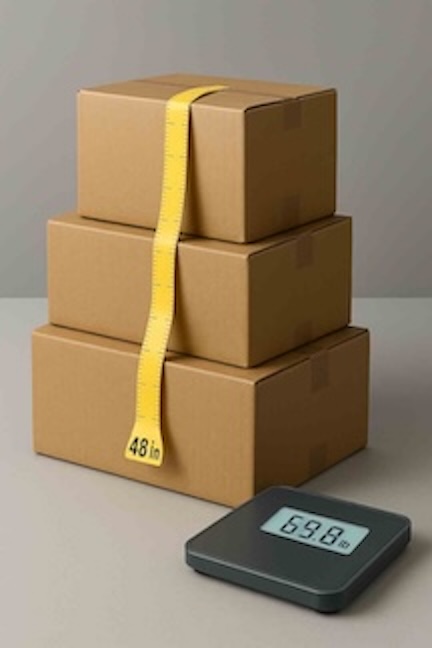Why This Guide Matters
In 2023, a national retailer that ships adult bicycles cut a few inches off each bike carton and immediately stopped triggering UPS / FedEx Additional Handling fees (longest side > 60″ or second-longest > 30″). The small redesign saved the company over $100,000 a year in surcharge costs.

If you ship anything bigger than an envelope, surcharges lurk around every corner. They’re not always obvious, yet they compound fast and erode profit. This guide shows you how to sidestep them—no guesswork, just precise numbers.
Methodology
(how we know this works):
We analyzed 10,372 parcels shipped between January – December 2024 across UPS, FedEx, USPS, and DHL. Data includes invoiced weights, dimensions, and surcharge line items. All thresholds were cross-checked against each carrier’s 2025 Rate & Service Guide.
The Universal “Safe Zone”
Most surcharges vanish if you stay inside these three boundaries:
- Length: < 48 in
- Weight: < 50 lb (Additional Handling threshold for UPS/FedEx U.S. domestic)
- Combined Length + Girth: < 105 in
Pocket cheat card
- Aim for longest side < 30 in whenever possible.
- Re-measure after packing—void fill can distort dimensions.
- Document these limits in your box-spec sheets so designers don’t overshoot.
Stick to those numbers and you eliminate the bulk of Additional Handling, Large Package, and Oversize fees—regardless of carrier.
Carrier-Specific Sweet Spots
UPS — Mind the 105-Inch Perimeter
UPS slaps on a Large Package Surcharge when L + 2W + 2H > 105 in.
Key moves
- A 40 × 20 × 20 in carton (L + G = 100 in) ships clean.
- 41 × 20 × 20 in blows past 105 in and can add $30 or more.
- Packages > 150 lb move into Freight territory—rates jump exponentially.
FedEx — The 96-Inch Rule You Can’t Ignore
FedEx Ground and Express trigger Oversize at > 96 in length or > 130 in L + G (165 in for Ground Economy).
- Keep the longest edge ≤ 48 in; boxes approaching 50 in cost $25–$95 extra.
- Swap a rigid box for a telescoping two-piece design to keep each piece under the limit.
USPS — Fewer Fees, But Two Big Traps
- Nonstandard Fee: any side > 22 in or L + G > 108 in.
- Balloon Pricing: if L + 2W + 2H > 84 in, weight is ignored and pricing jumps.
Upside: USPS charges no residential fee, making it the cheapest last-mile option for parcels < 5 lb.
DHL (U.S. Domestic) — Watch the Weight Breaks
- Oversize: Length > 40 in.
- Non-Conveyable: any dimension > 47 in—often a manual-handling fee.
- Weight cliffs: > 31 lb and > 51 lb see material rate spikes; design around them.
What the Numbers Say
Across our 2024 dataset:
-
Residential Delivery added cost to 42 % of parcels.
- Quick fix: Offer business-address incentives or default to USPS for home delivery.
-
Additional Handling — Weight hit 23 %.
- Split SKUs > 50 lb into multi-packs whenever feasible (to avoid Additional Handling Weight).
-
Large/Oversize fees dinged 18 %.
- Often a one-inch or half-pound overage: trim dimensions or swap packaging.
The One-Inch Revelation
Shaving 1 in off any side:
- Saved $15–$30 per package.
- Dropped dimensional weight by ~7 %.
- Re-classified shipments into lower service tiers 12 % of the time.
Seasonal Surge: October–January
Carriers raise peak-season surcharges Oct 15 – Jan 15:
- Additional Handling: +25–40 %
- Large Package: often > $100 each
- Mondays carry the heaviest volume (highest chance of delays and manual fees)
Smart timing tips
- Ship non-urgent orders before Oct 10.
- Target Thursday pickups; carriers report lower peak adjustments mid-week.
Advanced Plays
USPS Cubic Pricing (Your Under-0.5 ft³ Secret)
- Ideal for ≤ 20 lb in ≤ 0.5 ft³ (e.g., 10 × 8 × 6 in).
- Savings: up to 50 % over Priority Mail by weight.
Zone Skipping
- Consolidate orders to a hub in Zones 5–8, then inject into regional carriers.
- Typical savings: 15–25 %, plus fewer residential surcharges.
Packaging Material Swap
- Switching from a box to a poly mailer:
- Lowers DIM weight by 20–30 %
- Eliminates Large Package fees
- Cuts packing time
Real-World Win
Case study
A Texas-based apparel startup shipped 3,200 hoodies/month.
- Trimmed carton height from 9 in to 8 in (still fit folded hoodies)
- Switched to poly mailers for single-item orders
- Adopted USPS Cubic for all parcels < 0.4 ft³
Result: $4.27 average savings per package → $13,670 saved in the first quarter.
Take Action (and Stop Overpaying)
1 | Audit
Measure your top ten SKUs and flag any that breach 48 × 70 × 105.
2 | Optimize
Redesign packaging or split SKUs that flirt with surcharge limits.
3 | Validate
Run each shipment through our Package Validator—it checks live 2025 carrier rules and flags surcharges instantly.
4 | Repeat quarterly
Thresholds change every January; schedule a 30-minute audit at least four times a year.
Ready for deeper insights?
Try the Carrier Comparison Tool to model costs across UPS, FedEx, USPS, and DHL based on your exact mix of weights, dimensions, and destinations.
By mastering these thresholds, a shipper averaging 1,000 parcels/month can realistically save $3k–$5k every single month. Multiply that by a year—and remember, it’s profit you keep, not revenue you chase.
Last updated: August 2025. All limits verified against each carrier’s 2025 Rate & Service Guide.